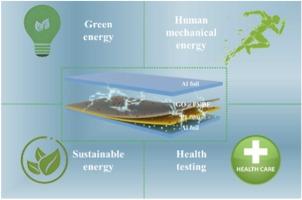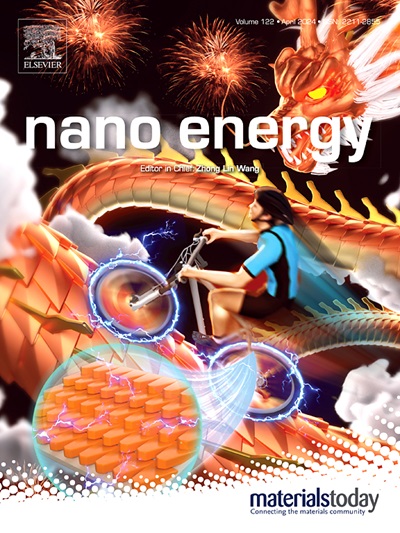Enhanced performance of TENG through graphene oxide and transition layer coupling: Achieving green energy harvesting and powering wearable devices
IF 16.8
1区 材料科学
Q1 CHEMISTRY, PHYSICAL
引用次数: 0
Abstract
Triboelectric nanogenerators (TENGs) offer a novel approach to harvesting green energy due to their simple structure, low manufacturing cost, and suitability for collecting low-frequency mechanical energy. Previous research has primarily focused on the impact of single factors on the electrical output of TENGs, such as the generation, storage, or loss of triboelectric charges. In this study, we enhanced the generation of triboelectric charges by introducing graphene oxide (GO) and reduced charge loss through a Polyimide (PI) film as a transition layer. By combining both, we maximized the electrical output performance of the TENG. The ISC, VOC and charge of the optimized TL-TENG are 33.23 μA, 318.52 V and 152.03 nC, respectively, with a maximum output power of 2.6 W/m2. The results indicate that the performance enhancement from the transition layer exceeded that of GO alone, possibly because it reduced the electron drift rate by 97.37%. Additionally, the TL-TENG demonstrated excellent mechanical durability, with ISC decrease of only 2.25% after 5×104 contact-separation cycles. The device also showed effective metal anti-corrosion properties and could harvest energy from mechanical vibrations and human motion, powering at least 107 LEDs and supporting small electronic devices such as digital watches. The outcomes of this study hold promise for providing reliable energy sources for wearable devices and offer theoretical guidance for designing high performance TENGs.

通过氧化石墨烯和过渡层耦合增强 TENG 的性能:实现绿色能源采集并为可穿戴设备供电
三电纳米发电机(TENGs)结构简单、制造成本低,而且适合收集低频机械能,因此为收集绿色能源提供了一种新方法。以往的研究主要集中在三电荷的产生、存储或损耗等单一因素对 TENG 电输出的影响。在本研究中,我们通过引入氧化石墨烯 (GO) 增强了三电荷的产生,并通过聚酰亚胺 (PI) 薄膜作为过渡层降低了电荷损耗。通过两者的结合,我们最大限度地提高了 TENG 的电输出性能。优化后的 TL-TENG 的 ISC、VOC 和电荷分别为 33.23 μA、318.52 V 和 152.03 nC,最大输出功率为 2.6 W/m2。结果表明,过渡层带来的性能提升超过了单纯的 GO,这可能是因为过渡层将电子漂移率降低了 97.37%。此外,TL-TENG 还具有出色的机械耐久性,在 5×104 次接触分离循环后,ISC 下降率仅为 2.25%。该装置还显示出有效的金属防腐性能,并能从机械振动和人体运动中获取能量,为至少 107 个 LED 供电,支持数码手表等小型电子设备。这项研究成果有望为可穿戴设备提供可靠的能源,并为设计高性能 TENG 提供理论指导。
本文章由计算机程序翻译,如有差异,请以英文原文为准。
求助全文
约1分钟内获得全文
求助全文
来源期刊

Nano Energy
CHEMISTRY, PHYSICAL-NANOSCIENCE & NANOTECHNOLOGY
CiteScore
30.30
自引率
7.40%
发文量
1207
审稿时长
23 days
期刊介绍:
Nano Energy is a multidisciplinary, rapid-publication forum of original peer-reviewed contributions on the science and engineering of nanomaterials and nanodevices used in all forms of energy harvesting, conversion, storage, utilization and policy. Through its mixture of articles, reviews, communications, research news, and information on key developments, Nano Energy provides a comprehensive coverage of this exciting and dynamic field which joins nanoscience and nanotechnology with energy science. The journal is relevant to all those who are interested in nanomaterials solutions to the energy problem.
Nano Energy publishes original experimental and theoretical research on all aspects of energy-related research which utilizes nanomaterials and nanotechnology. Manuscripts of four types are considered: review articles which inform readers of the latest research and advances in energy science; rapid communications which feature exciting research breakthroughs in the field; full-length articles which report comprehensive research developments; and news and opinions which comment on topical issues or express views on the developments in related fields.
 求助内容:
求助内容: 应助结果提醒方式:
应助结果提醒方式:


